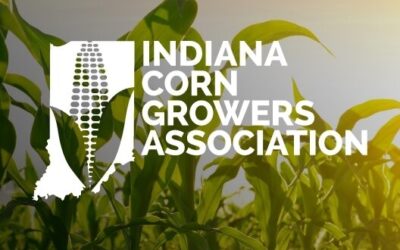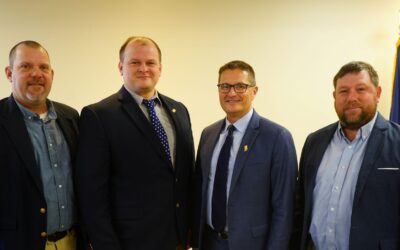Indiana Corn and Soybean Forum reviews state’s grain indemnity program
INDIANAPOLIS, Ind. (Dec. 4, 2020) — Benjamin Franklin said, “An ounce of prevention is worth a pound of cure.” Although Franklin may never have traveled through Indiana, many Hoosiers appreciate the wisdom in his words. Storing away a little extra for a rainy day is common practice for many Hoosiers, and this is why the Indiana Grain Indemnity Corporation (IGIC) and the Indiana Grain Indemnity Fund exist. Possible legislative changes to the grain indemnity program was a focus of Thursday’s session of the Indiana Corn and Soybean Forum.
The Forum is an annual event produced by the Indiana Soybean Alliance (ISA) and the Indiana Corn Growers Association (ICGA). This year’s Forum, due to COVID-19 restrictions, is virtual instead of in-person. Bane-Welker Farm Equipment and First Farmers Bank and Trust are the presenting sponsors for this week’s Forum.
The session featured the opinions of Amy Cornell, President of the AgriBusiness Council of Indiana; Andy Tauer, Director of Public Policy for Indiana Farm Bureau; and Steve Howell, Senior Director of Industry Affairs for ISA, ICGA and the Indiana Corn Marketing Council (ICMC). Indiana’s grain indemnity program was established by the state government in 1995 to protect farmers from the financial failure of a licensed grain buyer.
The Indiana Grain Indemnity Fund is voluntarily funded by farmers who pay a producer premium equal to two-tenths percent of the price on all marketed grain that is sold in Indiana. When a licensed grain buyer fails, farmers who have not requested or received a premium refund can receive 100 percent payment on storage losses that occur at a licensed warehouse, or 80 percent payment on all other financial losses from grain delivered to a licensed grain buyer.
Howell said, generally speaking, Indiana’s grain indemnity program is considered a good insurance policy against the failure of a grain buyer. However, he added, the state’s General Assembly will consider several changes to the program during next year’s session, which begins on Jan. 4, 2021. Some of the possible changes to the program include:
- Require a third-party actuarial study of the IGIC fund every five years.
- Provide a third-party performance review of the Indiana Grain Buyer’s and Warehouse Licensing Agency (IGBWLA) auditing processes.
- Provide funding for IGBWLA to further train auditors, conduct an actuarial study and third-party review of IGBWLA auditing processes. Training must be relevant to the regulatory functions.
- Increase communication and transparency between the IGBWLA and the IGIC.
Ed Ebert, Senior Director for Grain Production and Utilization for ISA and ICMC, wrapped up Thursday’s session by saying the soybean and corn prices have significantly improved in the past few months, and he is optimistic that this trend may continue in the months ahead. Ebert explained that many economic circumstances have aligned to create this positive price trend.
“Export sales have been stellar for U.S. ag products this year,” he reported. “Plus, USDA lowered crop production estimates for both corn and soybean crops throughout the growing season. As a result, carry out stocks in both soybeans and corn are at multi-year lows.”
In addition, Ebert said, delayed planting and uncertain weather in South America have built risk premiums for U.S. farmers. Lower crop estimates from Brazil coupled with a later planting season allows for a longer window of opportunity for U.S. exports for customers that typically buy corn and soybeans from South America.
Of course, there are still warning signs to monitor in the coming month, Ebert said. The recent spread of the COVID-19 pandemic could cause additional lockdown measures, which would impact domestic demand. And, global crush margins are under pressure with dislocated demand between soybean meal and soybean oil. Also, some reported cancellations of overseas’ shipments of U.S. ag products are not a worry at present, he said, but it should be watched.
The Forum’s final session will be from noon to 1 p.m. on Friday and feature Nick Welker, who will talk about faith, family and farming from his home in Montana. Welker Farms has hundreds of thousands of followers on YouTube, and their audience continues to grow. Nick farms with his father, Bob, and his brother, Scott, on the farm that has been in their family since 1912. Using large machinery and the latest in technology, the Welkers manage more than 10,000 acres and grow spring wheat, winter wheat, yellow peas and garbanzo beans.
The last session of the Forum is available on Zoom, and there is no charge. Attendees must register at least 30 min prior to each session at indianasoybean.com/forum
####
About Indiana Soybean Alliance Membership and Policy Committee: The ISA Membership and Policy Committee works to enhance the viability of Indiana soybean farmers through the advocacy and promotion of state and federal policies. ISA Membership and Policy Committee is led by members of the Indiana Soybean Alliance farmer board who are charged with directing advocacy efforts on behalf of more than 600 dues-paying members. Learn more at www.indianasoybean.com
About Indiana Corn Growers Association: The Indiana Corn Growers Association works with state and federal governments to develop and promote sound policies that benefit Indiana corn farmers. The ICGA consists of nine farmer-directors who provide leadership to the organization on behalf of more than 800 members statewide. Learn more at www.incorn.org/icga
This communication was NOT funded with Indiana corn and soybean checkoff dollars.
Posted: December 3, 2020
Category: ICGA, ICGA Press Releases, ISA, ISA Press Releases, Press Releases




